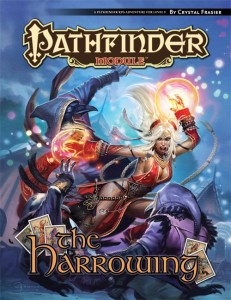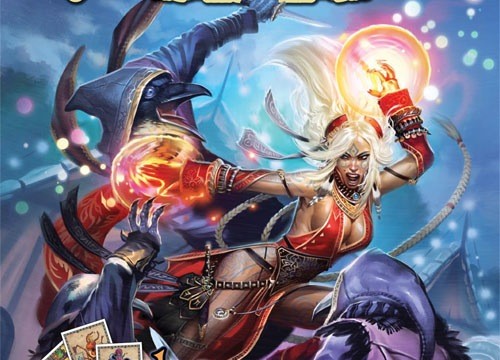 Are you a new GM or a veteran looking for ways to improve your GMing skills? Take a peek Behind the Screens, a twice-monthly advice column dedicated to making you a better GM. A seasoned gamer and GM, Anthony Li offers his thoughts on all sorts of GM related topics as well as in-depth reviews of published adventures by Paizo and other 3rd Party Publishers.
Are you a new GM or a veteran looking for ways to improve your GMing skills? Take a peek Behind the Screens, a twice-monthly advice column dedicated to making you a better GM. A seasoned gamer and GM, Anthony Li offers his thoughts on all sorts of GM related topics as well as in-depth reviews of published adventures by Paizo and other 3rd Party Publishers.
The Harrowing is a 36-page adventure module by Crystal Fraiser suitable for a group of 9th level PCs. It’s an excellent example of a sandbox style adventure with a fairy tale feel straight out of a Brothers Grimm story. It’s exciting, evenly paced, and makes use of the Harrow Deck to allow for a more immersive roleplaying experience. The Harrowing is a creative and unique adventure that stands out for its wonderfully flavored additions to Golarion’s background lore.
If you want your adventures to contain a little bit more than the traditional dungeon hack-and-slash, this adventure is for you. If you like your fairy tale stories with a slightly dark bent, this adventure is for you. If you want to learn more about the land of Varisia or know more about Varisian ethnic identity, this adventure is for you. I’ll cover what I mean by all this and more in the review to follow. But warning, this article is for GM’s eyes-only so spoilers abound!
The Setting
The meat of this adventure, that is to say all of the encounter areas, take place on a demiplane called the Harrowed Realm. There’s a sidebar with planar traits on the top of page 7 and small section on the realm’s inhabitants, the Storykin, on the bottom of page 4. If you’re prepping this adventure I suggest you read those first. It’ll give you a great idea of how different this adventure is from your typical sword and sorcery stories. The Harrowed Realm, as well as its denizens, is a wonderfully imaginative and dark reflection of the type of stories we might have heard or read as children. Indeed, the implication is that the characters and story events that are within the Harrowed Realm would be quite familiar to the Varisians of Golarion.
The Background
The Harrowed Realm has a tragic past dating back millennia to Golarion’s Age of Darkness. Sonnorae, a Varisian bard, desired only to live forever in a pocket dimension surrounded by the beloved stories of her people. She created a conduit between the Harrowed Realm to the Material plane from her two of her family’s ancient heirlooms. One was a kapenia, a traditional Varisian scarf that she took with her into the Harrowed Realm, the other was the Deck of Harrowed Tales a Harrow Deck that she left on the Material plane.
But her innocent dream was destroyed when the characters in her stories, driven mad by the repetitive nature of their lives, physically manifested and murdered her. They devouring her body gaining a measure of free will in the process and sundered her kapenia, each taking a piece for themselves. Still trapped within the Harrowed Realm, the eight Conspirators of Sonnorae’s demise have divided rulership of the demiplane among themselves, the mightiest of them, Zassrion – a blue dragon – occasionally reaching out to corrupt and influence anyone who carries the Deck of Harrowed Tales.
Adventure Overview
While searching for an NPC of interest, the PCs fall victim to a trap and are forcibly sent to the Harrowed Realm, now a demiplane of nightmarish fairytales. In order to escape the PCs must gather up the scattered pieces of Sonnorae’s ancestral kampenia. Once repaired, the bard’s heirloom will open the portal home. Unfortunately each of these tokens is in the possession of a unique and powerful denizen of the Harrowed Realm, the Conspirators of Sonnorae’s demise. The PCs must beg, borrow, steal or otherwise acquire the kapenia pieces or else be trapped in the Harrowed Realm forever.
Unlike many other published adventures, the Harrowing has an incredibly flexible story progression. Aside from the opening and concluding scenes the narrative is left pretty much entirely in the hands of the PCs. The Harrowing is divvied up into nine separate encounter area that can, with the exception of the first and last, be tackled in any order. Each Conspirator’s domain is like a self-contained mini module that exists somewhat independently of the others. In addition, there are two triggered event encounters that occur whenever the PCs acquire three and six kapenia pieces respectively that serve to bookend important milestones in the PCs’ progress in escaping the Harrowed Realm.
The Harrowing also makes extensive use of the Harrow Deck, a periphery item available from Paizo. This deck of setting appropriate cards is modeled after the real life tarot deck and players’ familiarity with a Harrow Deck can have great mechanical benefits for their characters. Because of the intrinsic link between the Harrowed Realm and the Deck of Harrowed Tales, many of the encounters that the PCs will experience in the demiplane can be affected or altered by invoking a specific card in the deck. If you’re going to run the Harrowing I would strongly suggest you also pick up a Harrow Deck as its physical presence at the table can do wonders to increase the level of immersion for your players. You can read about how the author intends for the Harrow Deck to be used here.
GM Advice
The Harrowing’s flexible modularity has both its pros and cons. On the one hand, it allows your players to explore the Harrowed Realm organically in whatever direction they choose. They have the liberty to decide which Conspirator they confront next and can act on whichever lead is most important to them. On the other hand there’s the potential pitfall of repetitive encounters. The PCs enter a Conspirator’s domain, defeat some lackeys, and either fight or negotiate for the Conspirator’s kapenia token. Lather, rinse, repeat.
The primary way to avoid this lies in making each encounter with a Conspirator as memorable as possible. Fortunately the author’s creativity in this regard makes it fairly easy to do so. Each encounter area is effectively set up as self-contained vignette. Essentially a fairy tale within a fairy tale. Characters in fairy tales tend to be defined by a few simple qualities that are emphasized in the extreme. They’re bombastic and over-the-top caricatures of reality. The Jungle Book’s Shere Kahn, for example, is embodied by arrogance, jealousy, and rage while the lovable Baloo displays slothfulness and beneficence in equal measure.
The Conspirators are no exception to this. Remember that the Conspirators in the Harrowed Realm are drawn from of Varisian folk legend physically manifest. Each can be defined by a short list of qualities. For example I would describe Bernaditi – the first Conspirator that the PCs are likely to meet – as jovial, glib, and mythomaniacal. The Conspirators’ personalities are well crafted with each possessing both redeeming and damning qualities and PCs could be inclined to react one way or another based upon how you decide to portray them.
It’s also important to realize that while each Conspirator is a powerful combatant and could readily provide a challenging encounter, there’s no reason that the PCs can’t acquire kapenia tokens in a peaceful manner. Each Conspirator has different quirks and foibles that, if exploited, can turn a dangerous NPC into a staunch and dependable ally. At the same time PCs shouldn’t expect to be able to talk their way out of every encounter. The PCs may find Conspirator’s prices too high to pay or that working with certain Conspirators conflicts with some PCs’ morals. However, as it is presented in the module, the inner workings of Conspirator politics is such that crafty PCs might find great rewards in playing Conspirators off of one another.
The single most important piece of advice I would give a GM preparing to run the Harrowing is to develop personalities for the Conspirators. So much depends on the portrayal of these NPCs and a flat performance can result in a repetitive grind and a tragic waste of the potential of this module. Conversely, memorable Conspirators, with their quirks well roleplayed can bring a unique twist to the adventures that your players are unlikely to have experienced before. And remember, if you ever get stuck just ask yourself, “How would this happen in a fairy tale?” You won’t be far from the mark.
In addition, you can find more advice from the Harrowing’s author on how to portray the Conspirators, Bernaditi and Brambleson, on the Paizo message boards.
Final Thoughts:
Overall I would recommend the Harrowing to groups that enjoy adventures that skew towards the stranger side and appreciate moderate to deep immersion in their roleplay. The Harrowing has creative and interesting NPCs and a unique spin on adventure telling. If your group just wants to kick down the door, kill monsters, and take their stuff, I would suggest looking elsewhere. But for the groups who enjoy heavy flavor and fluff with a pinch of sandbox exploration, the Harrowing is a great pick.
Have any thoughts or questions regarding the Harrowing? Leave them in the comments section below!







Excellent review, I have wanted to place this for a long time but now more then ever.